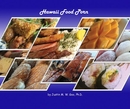Stuffed Duck from Golden Duck Restaurant
The classic approach to Chinese stuffing is seen in Cantonese stuffed duck. The stuffing consists of barley, minced mushrooms, ginkgo nuts, and occasionally some water chestnut. It's a very earthy mixture. The only thing is that I don't really care for barley. I adore the duck that surrounds the stuffing, it is perhaps the most tender duck preparation of them all. And the skin. The skin is just melt in your mouth to die for. The most buttery, outrageously soft skin anywhere. But I just don't care for the stuffing inside of that duck, mainly because I just don't like the texture of barley. So I came up with my own recipe for Chinese stuffing based on an entirely different Chinese flavor set, lup cheong (or Chinese smoked sausage) and hau yau choi sum (oyster sauce choi sum). So here is what you'll need:
- 1 package of lup cheong (or Chinese smoked sausage) - Don't buy the brand from Costco, it tastes funny
- 2 bundles of fresh choi sum - It may seem a lot, but remember vegetables shrink a lot when you cook them
- 1 bag of unseasoned bread crumbs or stuffing mix
- 1 can of sliced ma tai (or water chestnuts)
- some doong gu (black shiitake mushrooms)
- some ha mai (the little dried shrimp)
- some hau yau (oyster sauce)
- some shoyu
- and 1 can of chicken broth
Ingredients for my Chinese Style Lup Cheong Stuffing
Soak the dried doong gu in water. You pretty much always have to do this when cooking with doong gu, in order to rehydrate them. The water itself is pretty useful too, as it will contain all the flavor of the mushrooms.
Slice up the lup cheong into little 1/2 finger digit pieces. If you want your stuffing chunkier you can make them a little larger.
Slice up the choi sum in the same lengths as the lup cheong.
Here's what you do:
First fry up the lup cheong. Ideally, you want to use a non-stick pot, because then you can just toss them in without any additional oil. The oil from the lup cheong itself will come out, and you can use that to saute the rest of your ingredients. You don't need to use really high heat either, around 75% heat will do. Now, you really want to pay attention here. Because it was Christmas and I was so rushed, and I wanted to take pictures to put up here, I wasn't watching the pot like I should have been. You need to keep stirring this dish, otherwise things start to burn. So my lup cheong got a little charred. It wasn't so much that you could taste the burn, but it was more black than I wanted it to be You really just want a nice dark red color, just as it begins to char.
When the lup cheong is ready. Turn the heat down to about 50%. You can throw in your ha mai and your waterchestnuts. Drain off most of the water, and you can throw in your mushrooms as well. Pour in the shoyu and oyster sauce to taste. Be careful when putting in that oyster sauce. It's very strong stuff, and if you put too much of it in, your stuffing will come out pretty salty. Stir this around for a few moments to let it saute together.
After a few moments of cohesion, toss in all of your choi sum. The 2 bundles is going to seem like an awful lot, and will probably fill the pot to the brim. But keep in mind that vegetables seriously shrink when you cook them. So just stir everything around for a while, and very soon your vegetables will be on par with everything else.
Now turn down the heat again to about 30% and cover the mixture with your chicken broth. 1 can ought to be enough to just cover all of the ingredients. If it isn't you can add more, but remember, if you add too much your stuffing will be too soggy.
Finally, add about half the bag of stuffing mix. That should be just about the right ratio of breadding to stuff. If it seems too salty for you, you can always add more bread, but if it seems to bland, there really isn't any way to take the extra breadding out. So add it in small increments until the ratio looks right. Keep mixing until you've got a nice stuffing consistency. Then turn the heat down to about 10%, and cover and let it simmer for a few moments. This makes everything meld together into a cohesive mixture.
Congratulations, you've just made Chinese Lup Cheong Stuffing!
Cooking is fun isn't it? My mom said told me she is often surprised that in Chinese families, it is the men who are the better cooks. That's because Chinese men really like to eat, so they have a passion for cooking and creating something that tastes good. It is a passion that I want to instill into my boys. That's pretty much how it panned out at Christmas, when I helped my first son make his first tuna macaroni salad. He entusiastically gobbled down his own creation with pride and joy.














looks ono brah.
ReplyDeleteda little boy's dish was da most ono of all!!! =)
ReplyDeleteThis article is probably ages old, but I think jus’ local style culture in Hawaii. The men are truly the cooks of the house. I was brought up by a cooking/ catering Ohana and although my Sunties did cook, the Maestros of the kitchen were the men. Mahalo for sharing!!!
ReplyDelete